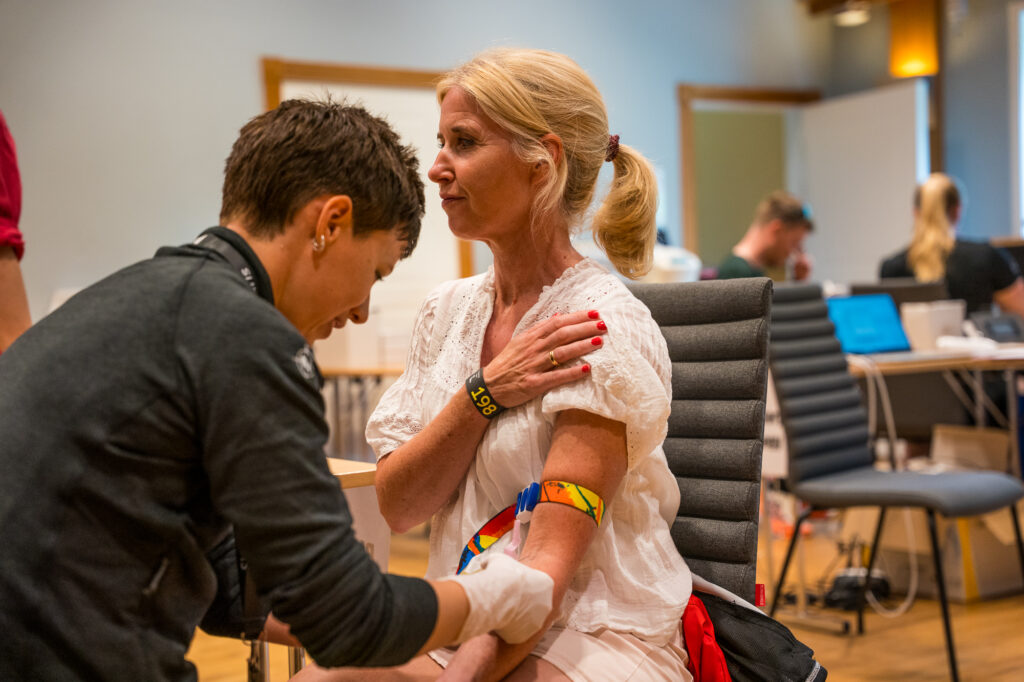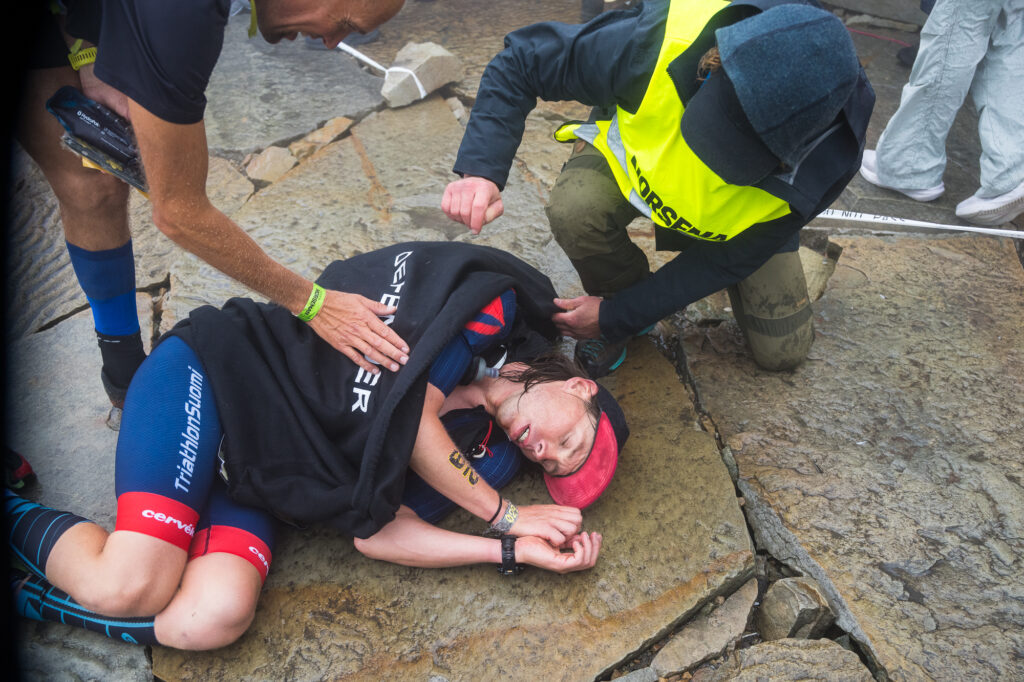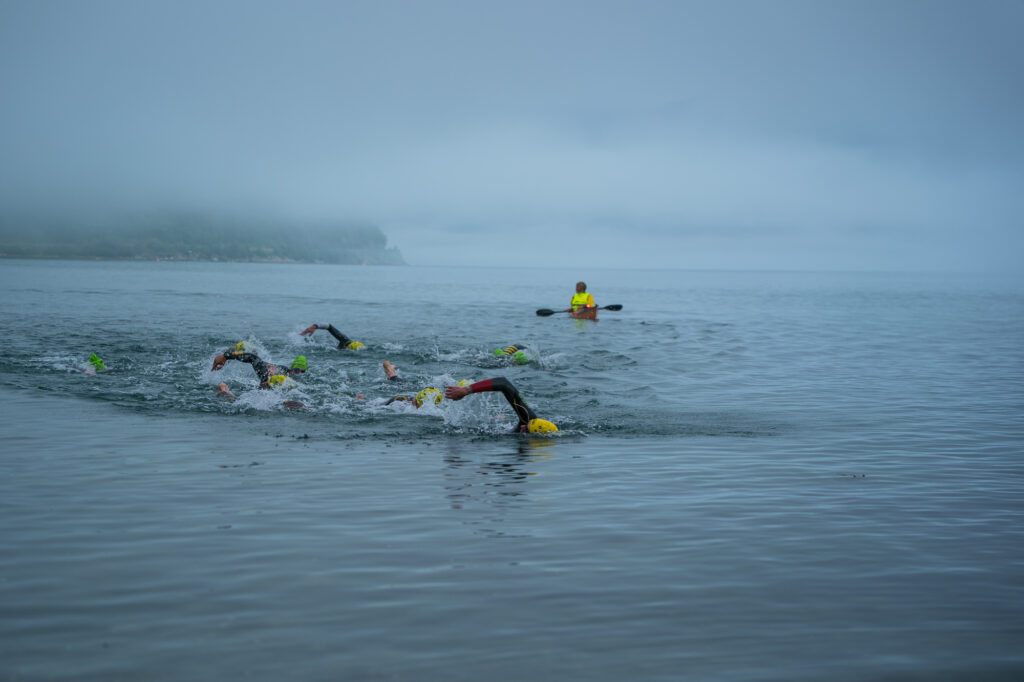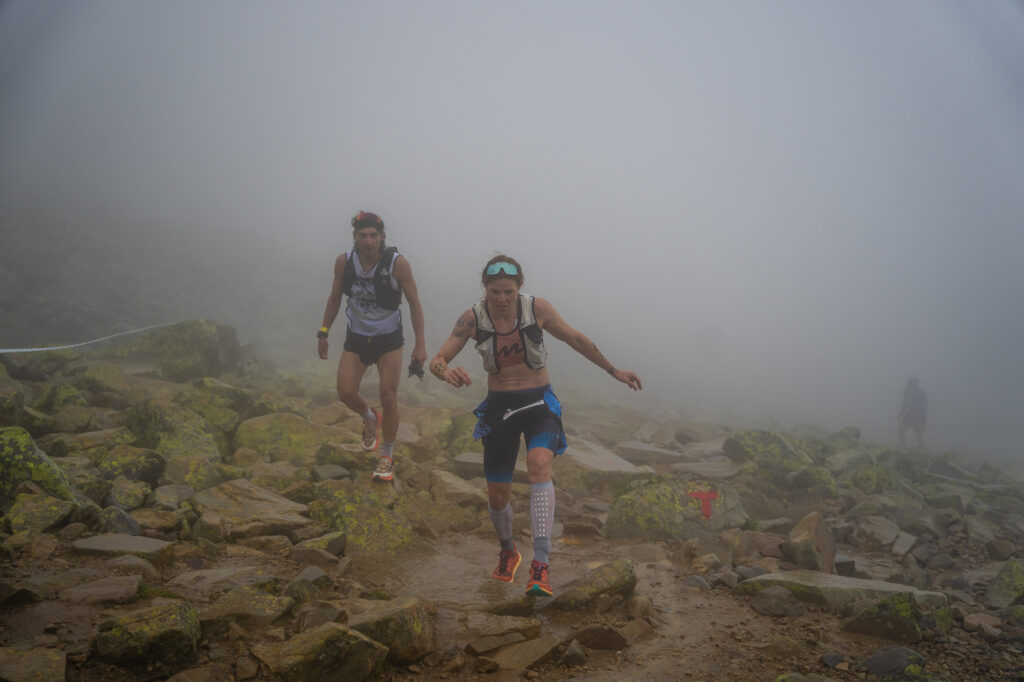Researching the Physical Toll of Racing Norseman

A Norseman athlete gets her blood taken as part of the race’s biomarker research. Photo: Kevin Mackinnon
The Norseman Xtreme Triathlon is one of the toughest races on the planet. So tough, in fact, that for the past 10 years, race organizers have brought researchers to the event to test athletes and see just how much of a toll the gruelling 140-mile course takes on their bodies. Jonny Hisdal, professor of clinical physiology at the University of Oslo, has spearheaded this initiative since it started in 2015, collecting data from hunreds of Norseman finishers in the past decade.
A Focus on Safety
Safety is the word of the week in the days leading up to Norseman. Every race official and volunteer preaches the importance of safety to all racers and their support crews. The event is brutal and it pushes athletes to their limits, and organizers want to ensure that everyone is in the best position to not only be successful at the end of the race, but to leave happily and healthily.
In 2015, the safety of athletes came into question before the race, as the water temperature in Eidfjord was coming in at a very cold 50 Fahrenheit.
“We were not sure if it was safe to swim the full distance,” Hisdal says as he waits for athletes to flow into the research section of pre-race check-in. After they register and receive their race kits, athletes are asked if they would like to be a part of the study. If they say yes, Hisdal and his team run a number of checks, including lung and blood tests.
Hisdal says he and the Norseman team tried to find literature and existing research on the safety limits of cold-water swimming. They also tested it themselves, swimming in the fjord and running tests immediately after.

Athletes are pushed to their limits at the Norseman Xtreme Triathlon. Photo: Kevin Mackinnon
“It ended up with a shorter swim [that year],” he says. “We decided to have a half distance.” Some athletes weren’t happy with this decision, but by the end of the day, Hisdal and the other organizers agreed it was the right call.
“On the same day, a man died in another competition during the swim,” Hisdal says. The water at that race was a reasonable 66 F, so the incident likely had nothing to do with the swim or water conditions themselves, but Hisdal says the Norseman team realized how easy it would have been to blame organizers if the water had been colder.
“If that had happened in Norseman, we’d be criticized,” Hisdal says. “Everyone would react to the water temperature.”
Hisdal points to death rates at triathlons and other endurance events, noting that, unfortunately, they do happen, and often through no fault of the race itself. However, he adds that if there is something to do with the race (like water temperature) that could be just slightly linked to the incident, organizers will be blamed.
After the 2015 event, Hisdal and the others decided they needed to do more testing to see if the swim was safe or not. They reached out to athletes and asked if they would swim the full 2.4-mile course in 50-degree water.

Water temperatures in Eidfjord can be extremely cold. Photo: Kevin Mackinnon
“We measured [their] core temperature,” he says. “What we saw the first day was one of the athletes had a core temperature of 32 degrees celsius. After that, we decided we cannot swim that distance [at that temperature].”
They took more away from this test than just a hard no for swimming in extremely cold water. Hisdal says an athlete’s core temperature will drop at a “very steady rate” when they swim in cold water. That gave researchers a way to figure out just how much to cut the swim.
“If you only catch the slope of this drop, you can extrapolate the curve, then you can tell how long you can be in the water before it’s dangerous,” he says. “From that, we saw that you cannot swim the full distance in [50-degree] water. It’s not about the distance, it’s about the time — how long you’re exposed to the cold water.”
With that in mind, water temperature is monitored closely each year at Norseman, with organizers ready to make adjustments when necessary.
Watching Biomarkers
The research hasn’t stopped since 2015. Hisdal and his team now look at biomarkers in athletes’ blood.
“Those are signals that are coming from the heart, from the kidney, from the liver, from the muscles,” he says. When patients go to a hospital, blood tests will contain biomarkers that will indicate if they have suffered a heart attack, heart failure, kidney failure or a number of other things.
“The thing is that when you finish Norseman, the values you had at the finish line are the same as a seriously ill patient,” Hisdal says. “It looks like a heart attack, it looks like you have heart failure. But the thing is that you don’t have it. So, what we’re searching for now is what is the normal reference values for people that do such things.” Hisdal wants to find biomarkers that can differentiate between someone who has actually had a heart attack and an athlete who is simply exhausted, and Norseman is the perfect place to run these tests.
“This is the best test situation we could get, to do this field research, it’s such a unique opportunity,” he says. “You could never do this in a lab. You would not be allowed to do this in a lab. But these people do this by themselves.” Hisdal and his team are free to reap the benefits of such a tough physical test without having to answer an ethical or moral questions.

The Norseman course is as demanding as any other on the triathlon circuit. Photo: Kevin Mackinnon
The tests come in at least three (but sometimes four) parts. The first, as previously mentioned, is done before the race as athletes check in. The second is at the top of Mount Gaustatoppen (the end of the black course, which sees a maximum of 160 finishers), or at the white course finish line (anyone outside of the top 160 goes this route). They will be tested again the day after the race, and if an athlete is local or still in the area two weeks later, Hisdal and his team will test them then, too.
“It’s very important for us to see that these sky-high levels are normalizing again,” he says. “The day after, they’re not [normalizing] in everyone, but after 14 days, most are back to normal. So far it doesn’t seem that this makes any permanent damage.”
With a limited team and so many athletes finishing on both courses, they can only accept 35 people to test each year, but with 10 years of research under their belts, the overall testing numbers are rapidly climbing.
“If we could, we would test everyone, but we still [get good results] in the research we do,” Hisdal says. The plan is to continue to test athletes for as long as Norseman runs. As Hisdal says, it provides researchers with a tremendous and rare opportunity to study individuals who have pushed up to and past their limits. But the main reason for the testing — athlete safety — will never change.
For those that really want to dive into the studies
Jørgen Melau
Safety Director at Norseman Xtreme Triathlon
PhD in Cold Water Swimming
Researcher in Norwegian Armed Forces
Has provided this link here
Tags:
norsemanNorseman 2025sport researchsport sciencextrixtri world tourContinue the discussion at forum.slowtwitch.com
1 more reply




what a nonsense ( sorry for that ) atheltes push themselves to the limit in every race. from 60 seconds till whatever
that is very good
but again norseman is not really any better than another long distance race
they can only accept 35 people to test each year, but with 10 years of research under their belts, the overall testing numbers are rapidly climbing.
that is great 10 years data colection !
has the data been published ?
Have you been to norseman? or raced it?
Interested in the data too , includingthe finish. Also data can be skewed as the majority that sign up can deal with cold swims
Yes, lots of data from Norseman has been published. Up until now, we have nearly 20 papers published with Norseman related data.
I agree it can be skewed. But this is field research and not lab studies. So then there is always a risk of skewed data. However, we still think it is valuable data
Have a link for this data?
I for sure would not want to swim a full IM distance in 50 degree water. Any of the triathlons I have done with water in the 50s has been miserable. I know there is a lot of variability between athletes. As a 57 yr old guy now - I also know I have less tolerance to “handle” that cold water now vs when I was racing 40 yrs ago.
Could you please share a link to the publication or publications?
You can find most of them at my Research Gate site : https://www.researchgate.net/profile/Jorgen-Melau/research
Several has asked for link to the Norseman Research. The community flag my respons as spam when I link to our research. But you can find most of the research by serching on my name at google scholar or researchgate. You can find a few studies at the Norseman web pages as well.
@Aqua_biker @synthesis
I have updated the article to include some of the PDF’s and also a link to all of @jmelau published work on the subject…
Now who will be our helpful citizen to infographic the data?
CHATGPT